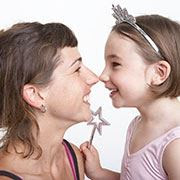Attachment: the basics
Attachment is the strong, long lasting bond between a baby and his caregiver.Secure attachment develops in response to consistent and sensitive love and care in the first months of your baby’s life. It gives your child an important start to healthy social, emotional and cognitive development, building the foundation for a sense of security, safety and good coping skills.
Babies attach to significant grown-ups in their lives. This is most often their parents but can also include other people who regularly care for them, such as grandparents and paid carers. Children can, and will, attach to more than one person.
Attachment to other people doesn’t affect your baby’s attachment to you – it helps her learn about being close to people.
Babies who experience care that is unresponsive, unpredictable or threatening can develop attachment problems that slow their development.
Understanding attachment behaviour
Babies and toddlers try to get comfort and protection from the people they’re attached to. Babies have different attachment behaviour to show different needs.To show they need attention, for example, young babies might:
- smile at you, or make eye contact – babies love to look into your eyes
- make little noises, such as coos or laughs
- crawl after you or hold out their arms
- copy your gestures
- look relaxed and interested
- cry.
- look away, shut their eyes or yawn
- try to struggle or pull away
- look tense and unsettled
When attachment behaviour isn’t followed by reassurance, babies can sometimes respond by feeling afraid and clinging even more. As an example, this could happen if a parent encourages a toddler to be ‘brave’ and independent before he’s ready.
Some
of your baby’s needs stay the same for years, including her need for
lots of love and attention, good nutrition, plenty of sleep and so on.
Some of these needs will change as she develops. It helps to understand
what stage of development she’s up to.
Building a secure foundation for baby’s development
The following tips can help you use attachment to ground your baby’s growth and development.- Provide comfort when your baby is crying or upset. If parents come to comfort them, babies learn that the world is safe, and they cry less.
- Take time to be with your baby. Try to learn to ‘read’ his messages – your baby depends on you to work out what he’s trying to communicate.
- Think about your baby as a separate person, with her own needs and feelings. For example, think about how a baby might feel when she’s picked up then put down somewhere else without warning, or what it would be like to be handed to a stranger. Be gentle when introducing new things and people, and let your baby know what you’re going to do so she learns that the world is predictable.
- See the world from your baby’s perspective. Imagine what he’s looking at, feeling or trying to do. Discover what he really likes and dislikes.
- Be flexible. Learn what works for your baby, and don’t stick to a certain routine if it doesn’t suit you both.
- Give your baby chances to succeed and make things happen. You can try to do this by putting a rattle close to her, where she can hit it to make a noise or crawl to reach it.
-
Find support for yourself
. If you’re physically and mentally well, you’ll be
better able to provide the love and comfort your baby needs for
attachment. Look for someone to talk things over with, to encourage you
when you’re doing well, and to give you a break when you need it.
Attachment and separation
By about six months, babies have usually developed important attachments, but might fear grown-ups they don’t know very well. This is a natural part of learning to feel safe in the world, and they’ll soon adapt to these new people too. Try to make sure you’re around for reassurance.At this age, it’s also common for babies to cry and experience separation anxiety when you leave them with someone else.
Over the next few years, babies and toddlers will gradually learn to manage longer separations from their special people. At first they’ll like to check that you’re around – they might even follow you into the toilet! But this is all part of building confidence.
By age three or four, children can usually manage a half-day or so with unfamiliar people (outside their circle of carers), without being upset. But some children take longer. It depends on their temperament and early experiences.
Separation and sleep
Babies who have slept well for their first six months or so might start to wake at night, or might not want to go to sleep. They could be experiencing separation anxiety, so you might want to read more about promoting independent sleep in babies over six months.
Some parents worry that controlled comforting will hurt attachment, but research shows that when this settling strategy is used appropriately, there’s no evidence it harms babies or attachment.




No comments:
Post a Comment